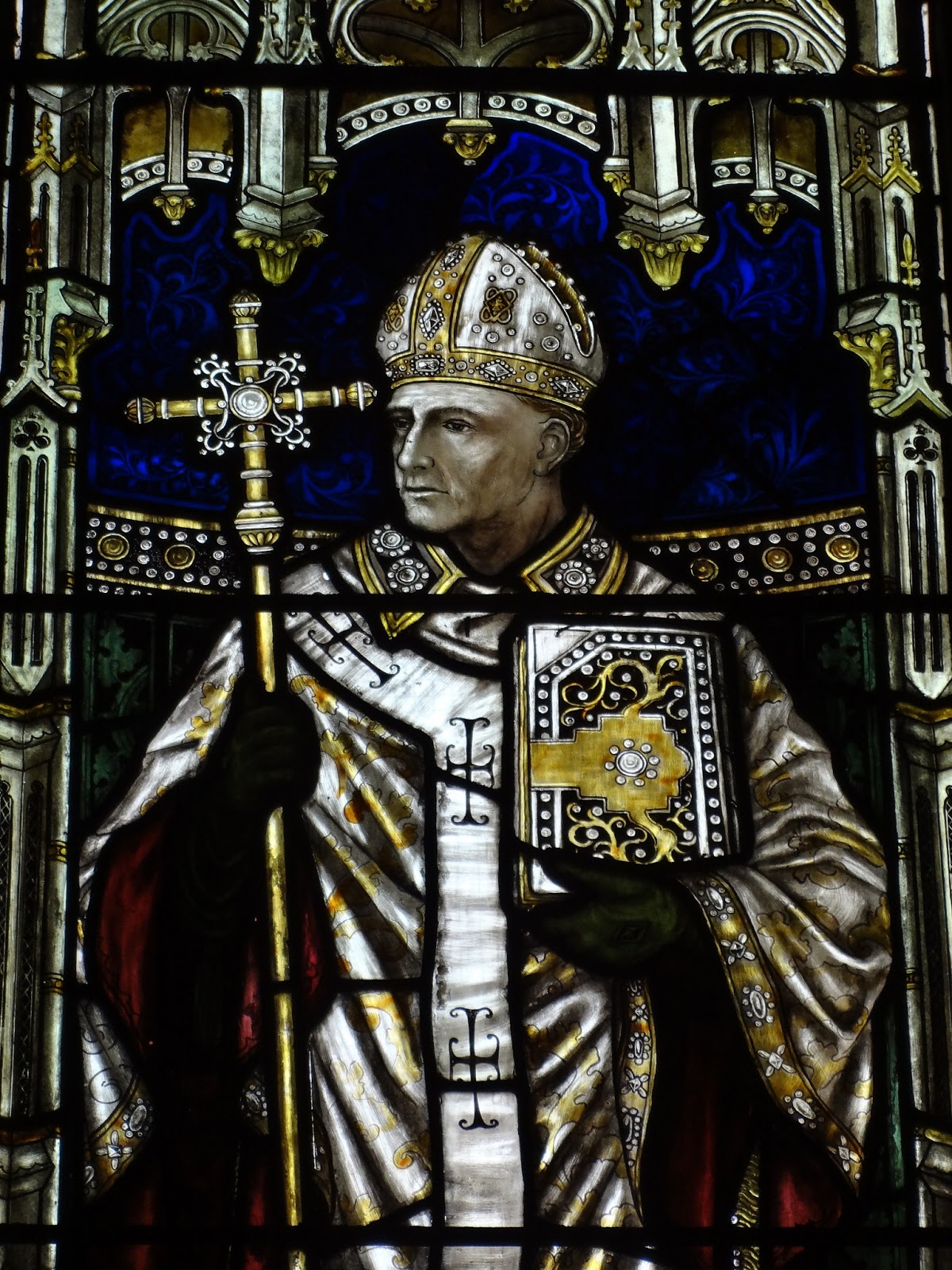Enjoy!

I know you all have been anxious to hear more about Lanfranc. Here’s the final installment. In the first two Lanfranc posts, I told you how William the Conqueror handpicked Lanfranc, a monk, for the role of Archbishop of Canterbury / quasi-political advisor in post-Norman Conquest England. Lanfranc styled himself “primate of England” and attempted to unify the English Church by instituting the rule of law. He was also chief negotiator on William’s behalf, dealing with foreign rulers and negotiating with rebels.
Remember that these events occurred from about 1066 through around 1081. This post will deal with how Lanfranc instituted the rule of law. Little did he know that his application of the law at that time would have an effect, hundreds of year later, on the common law of the U.K. and the U.S.
Again, most references herein are to Margaret Gibson’s and Helen Clover’s book Letters of Lanfranc. Other references are so specified.
As we have been seeing, Lanfranc attempted to unify the English realm via unifying the English Church. Secular and religious adjudication of disputes were entwined at the time; secular juries would come later. Thus, you’ll see Lanfranc dealing with both religious and non-religious cases.
Lanfranc used common law to support his decisions, and needed to “lay down” the canon law, so to speak, to make the rules clear. To this end, Lanfranc summoned and presided over the 1074-5 Council of London (Letter 11). All the heavies were there, including bishops and Archbishop Thomas of York. At the Council,the members renewed “some legislation” which had existed in “ancient law.”
Lanfranc provided rationale for his actions and legal decisions. At the Council, Lanfranc set forth rules regarding clerical and monastic life. For example, he confirmed monks’ “proper mode of conduct” pursuant to the Rule of St. Benedict. He further indicated that, “following many decrees of Roman popes and various texts of canon law, no one shall keep a strange clerk or monk in his household or ordain him without letters of commendation.” It was noted that the buying and selling of holy orders or of any position in the Church was prohibited (Letter 11).
Lanfranc was involved in individual cases, where tenets of canon law were violated. For example, Lanfranc advised Bishop Herfastof Thetford regarding the punishment of priests who had been “irregularly” ordained (Letter 24 and Letter 43). In doing so, Lanfranc cited several sources of canon law. He also presided over individual disputes. For example, he told Bishop Herfast that he would be arriving shortly to “give a most careful hearing to the claims of both sides and bring this long-drawn-out dispute to as definitive a conclusion as is possible” (Letter 42).
Lanfranc presided over a dispute where a bishop allegedly seized “by force” property and lands of the monastery of Coventry, and remained in the monastery “with [his] retinue for eight days eating up the monks’ provisions” (Letter 27). Lanfranc made it clear that it was not “within [the bishop’s] power to do these things” (Id). Lanfranc also directed another bishop to order his archdeacons to immediately return the money they wrongly demanded from their clergy (Letter 30). In doing so, Lanfranc reminded the bishop that, if any fault were found with the clergy, the procedure was for the clergy to be presented to Lanfranc directly to determine whether “punishment” was warranted. (Id).
Lanfranc was also involved with non-religious matters. He asked an Archbishop to restore property to a vassal of the King who had been robbed (Letter 25); and Lanfranc was consulted on how to adjudicate the issue of a man who had died while in captivity (Letter 40).
Lanfranc made sure to have evidence to support his findings. Indeed, this trend would continue with the development of jury trials later in England. When Lanfranc was consulted about what to do about men who wanted to leave their wives to marry someone else, he indicated that if a man denied that he had married the woman who was thought to be his wife, then “you should either show that he is lying, by reliable testimony or some kind of clear proof, or you should drop his case” (Letter 23). Lanfranc also instructed Bishop Herfast to “lay no claim to the property of St. Edmund unless you can give indisputable proof that it was claimed by your predecessors” (Letter 47). He further told Herfast to hold the claimants harmless “until the case comes into our own court and can be rightly concluded according to canon law and our own ruling as a judge” (Id). Lanfranc highly valued the legal process, and the unity it brought to England.
As an aside, apparently Bishop Herfast was a troublemaker because he keeps popping up in the letters. Indeed, in the beginning of Letter 47, Lanfranc indicates that the abbot’s clerk told him that Herfast “made a coarse joke” about Lanfranc’s letter, “uttered cheap and unworthy remarks about [Lanfranc] in the hearing of many,” and “declared with many an oath that [he] would give [Lanfranc] no assistance” (Letter 47). In characteristic fashion, Lanfranc dismissed that because he had more pressing things to discuss, but let Herfast know that he was on to him: “There will be another time and another place to speak of these things” (Id).
In the Trial of Penenden Heath, which was one of the most significant developments in early English law, Lanfranc argued that bishops should be tried before a lay tribunal. This case is significant because it reflects the attempt to maintain respect for Anglo-Saxon law while incorporating Norman law over the existing Anglo-Saxon structure. I’ll throw out one important piece of information here. It is not true that William’s Conquest suddenly led to this influx of all things Norman into England. The Conquest actually accelerated a process that had already begununder Anglo-Saxon rule. For example, one of the recent Anglo-Saxon kings had had a Norman wife, and Norman French was already spoken at the English Court.
One of the most significant controversies during Lanfranc’s tenure was what to do about clerical celibacy in England. This topic was addressed at the Winchester synod of 1076. At that time, Lanfranc had it decreed that no canon shall take a wife.However, regarding the priests who lived in villages and townships, if they had wives they “[were] not required to send them away; if they have none, they are forbidden to marry.” It was also decreed that in the future, bishops were prohibited from ordaining priests or deacons unless they first made a declaration that they were unmarried (Letter 41; see also footnote 4 of Letter 41). This rule was carried out; for example, Lanfranc advised Bishop Herfast not to make a man a deacon unless he sent his wife away (Letter 43). Lanfranc’s way of dealing with this reflects that he was a churchman, but was also politically practical. Indeed, he sought to avoid a possible insurrection by allowing those clerics who already had wives to keep them. (Note: By no means am I passing judgment on any of the Church rules here. I merely reiterate what happened).
As head of the English Church and as chief diplomat, Lanfranc was in contact with Guthric, king of Dublin (Letter 9), and with Toirrdelbach, king of Munster (Letter 10). He implored these rulers to impose canon law in their territories. In fact, Guthriceven sent an Irish bishop for Lanfranc to consecrate, after which he “sent him back to his own see with our letter of commendation, as was the custom of our predecessors” (Letter 9). Lanfranc implored Guthric to enforce canon law regarding marriage, including the prohibition on interrelated marriage and abandonment (Letter 9). Lanfranc was also in contact with Queen Margaret of Scotland (Letter 50).
And, finally, just because it’s interesting, Lanfranc himself was not above the rule of law. One historian points out that, apparently, during the Domesday survey Lanfranc was asked about his land holdings, so that they could be recorded (Letter 56, footnote 1 to Letter 56; see Domesday Book: A Letter of Lanfranc, by Frank Barlow, p. 284 ff.). Even he had to answer. Of course, the answer was no. Being an ordained priest, he had no private property of which to speak.
Lanfranc used legal precedent, custom and common law to unify the Church and, by extension, the English government. He knew that without the rule of law, there would be little chance of holding England together. Little did he know that the common-law tradition he used for what would ultimately be political ends would survive to modern-day Britain, and to a country he could not have even dreamed about.
To really dig deeply into this history, it would take more time and space than I have available on this blog. If interested, I encourage you to read further about Lanfranc and this fascinating period of history. As an interesting tidbit, Lanfranc outlived William, and assisted William’s son, William II Rufus, with maintaining control over England.
While the roots of U.S. common law can be traced to Lanfranc’s time, it was actually William the Conqueror’s direct descendant, his great-grandson, Henry of Anjou, who has a good claim as the founder of English common law. Ladies and gentlemen, Henry is where the real fun begins, so stay tuned.
Get helpful writing tips and more
in your inbox
Join the tribe and get free fiction and self-publishing tips.
Thank you for subscribing.
Something went wrong.

Be First to Comment